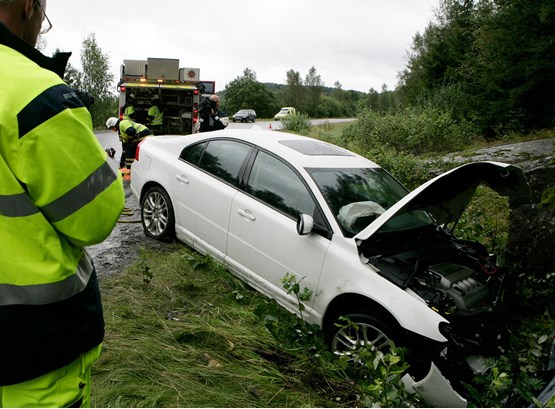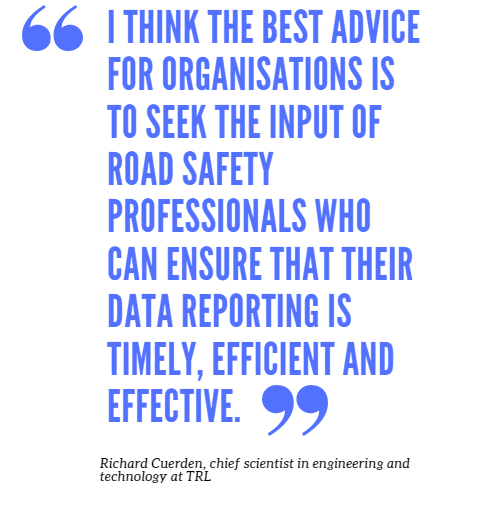Collisions are a costly part of business life, but thoroughly investigating why they happen can prevent similar incidents occurring again. Ben Rooth reports
Dealing with road collisions is an unfortunate part of a fleet manager’s life. As well as the safety implication of having drivers involved in incidents, the employer also faces costs from repairs, vehicle off-road time and lost productivity.
But while a collision is never good news, fleet managers can use the opportunity to find out the underlying reason for it and this information, in turn, can be used to prevent similar events occurring in future.

“Investigating road collisions provides the evidence base to understand how future collisions can be prevented or injuries mitigated,” says Richard Cuerden, chief scientist in engineering and technology at TRL, which runs a CPD-accredited vehicle accident investigation course for fleet operations and health and safety managers.
“Part of an active collision prevention strategy must involve learning lessons from previous incidents, identifying the trends and the priority areas to address.”
Cuerden adds: “The ultimate benefit is a safer fleet, happier and safer employees, and lower operating costs.”

Incidents happen suddenly and without warning, says the Royal Society for the Prevention of Accidents (RoSPA), so managing their consequences and learning from them requires the ability to act quickly and efficiently to avoid learning opportunities being missed.
This means organisations need well thought out and rehearsed processes for responding to incidents and near misses effectively.
Different companies may take different approaches, but RoSPA, which also offers a collision investigation course for fleet managers, says the essence of good investigation is to gather evidence from physical sources, documentation and witness interviews, and then reach conclusions, make recommendations, and communicate and implement any necessary improvements.
READ MORE: New drivers concerned over ‘reckless actions’ of other road-users, results reveal
RoSPA says the starting point for any organisation is to ensure a comprehensive accident and incident reporting and investigation policy is in place, and forms part of its ‘driving for work’ document.
This should define the terms used to describe different events. RoSPA uses ‘accident’, ‘incident’ and ‘near miss’:
- Accident is an event that results in personal injury to a staff member or another person, or results in property damage, categorised according to severity.
- Incident is a dangerous occurrence that breaches the organisation’s driving for work policy or safe driving practice and could include a motoring offence, or data from a telematics system.
- Near miss is a dangerous occurrence that has the potential to result in personal injury to a staff member or another person, or to result in property damage.
This policy should state that all work-related collisions and near misses (including damage-only ones and ones involving grey fleet vehicles) must be reported to a line manager or other nominated manager.
It should also state that all collisions, incidents and near misses will be investigated to establish how and why they occurred and to learn how to prevent them in the future.

In essence, the purpose of an investigation is to establish what happened, when, where, how, why, to who and with what consequences.
A fleet manager who is considering investigating incidents for the first time should “keep it simple”, says Cuerden.
“It is important to investigate all incidents regardless of whether anyone was injured or whether the extent of the damage or costs was low,” he adds.
“All incidents should be treated as opportunities to learn and improve. Start with the basics and by collecting facts.
“Following a collision, there will be a lot of opinion and even blame and this can be confusing and emotions can be charged, leading to a dilution of the facts.
“However, you must have clarity about why you’re investigating the incidents and what you want to objectively record – the aim being to measure risk.”

Rick Wood, head of fleet safety at RoSPA, says it is important to make it clear to drivers that any investigation is not a finger-pointing exercise.
“There can be a positive change in culture if investigations are carried out with transparency and without blame,” he adds.
“When incidents happen, the instinct is for drivers to try to deflect blame or even try to hide what’s happened.
“The issue with this is that if an unsafe practice isn’t dealt with early it can lead to something much more serious occurring in the future.
“The benefits of creating a culture of preventability are that lessons can be learned to avoid repetition and spread best practice throughout the organisation.”
RoSPA says incident reporting and investigation procedures should include:
- The initial response to an accident or incident – including emergency action.
- When an accident, incident or near miss needs to be reported.
- Who should report it; to whom it should be reported both internally and externally; and how this reporting should take place.
- The timescales within which it must be reported.
- The roles and responsibilities of the staff and managers involved.
- How the procedure works with the organisation’s HR policies, including its disciplinary policy.
- How the level of investigation is decided – according to its safety significance and learning potential – and who decides.
- The nature of the investigation and the resources that will be devoted to it.
- The evidence – including physical, witness interviews, documentation, telematics, dash cams – to be gathered.
- How the evidence will be analysed and integrated.
- The departments and managers who need to be kept informed.
- How the investigation, its conclusions and recommendations will be recorded and signed off.
- How the recommendations and conclusions that result from the investigation will be implemented.
Wood says it is vital that investigations discover “the true root cause” of any incident. “This is rarely a lack of driving skill and is much more likely to be about the internal and external motivators and beliefs that affect how a driver behaves,” he says.
“Look at the journey, the vehicle and the driver to establish what the risks are and how they can be mitigated.
“Most important is to identify the pressures exerted on the driver by the organisation – particularly the line manager.
“And pay particular attention to time pressures that may come from both the organisation and from within the driver themselves.”
Wood and Cuerden say the onus is on each organisation to decide for itself what information is of fundamental importance for it to ascertain what’s happened.

This needs to be clearly defined in its accident and incident reporting and investigation policy.
This data frequently includes driver and witness statements, photographic evidence, relevant details from insurers, telematics reports, dash cam evidence as well as professionally commissioned reports on individual driver’s abilities.
RoSPA says it is essential drivers know what they should do in the event of an incident.
One way to do this is to provide an accident/incident information pack to be kept in the vehicle, which drivers should complete and return to their line manager.
Fleet managers should draw up a list of the information drivers should collect as soon as possible after the event and provide a simple form to help drivers record the required information.

This should include:
- Date, time, place.
- Purpose of journey.
- Starting time.
- Environmental conditions (visibility, road surface condition and so on).
- Exact location (with reference to a fixed point).
- Sketch or a photograph of the accident scene.
- Position and direction of travel of vehicles and other parties.
- A brief account of what happened using clear language.
- Registration number, model and colour of other vehicle(s).
- Other driver’s name and address and contact details.
- Other party’s insurance company details.
- Damage to driver’s and other vehicle(s) and/or property.
- Injury to driver and/or passenger.
- Injuries to other parties.
- Names and addresses of any witnesses.
- Any other relevant factors such as personal health, stress, fatigue, etc.
RoSPA says when the information has been gathered, it should be entered into the organisation’s recording system for analysis.
This will help a fleet manager identify and measure trends and key risks, which will enable appropriate measures, such as targeted training, to be implemented.
RoSPA suggests that the findings of an investigation and the recommendations for action to prevent the event happening again should also be shared with all staff, for example through internal communications such as the intranet and noticeboards.
READ MORE: What causes collisions and how can fleets prevent them? Experts explain
Wood says: “Many incidents are similar in nature and lessons learned can lead to a reduction in their frequency.
“For instance, manoeuvring incidents can be reduced at points of delivery if a best practice method can be identified and communicated to all drivers.
“And if you can reduce repetitive incidents this can lead to cost reductions – particularly those that are hidden such as admin, downtime, hire-in of replacement drivers and vehicles plus any necessary time off work.
“These hidden costs are generally taken to be up to four times the bent metal costs.”
Cuerden adds: “I think the best advice for organisations is to seek the input of road safety professionals who can ensure that their data reporting is timely, efficient and effective. But all information collected must be kept within data protection guidelines to ensure its legitimacy.
“Furthermore, a proactive analysis of the information is vital and a relational database must be established to securely store the information.
“It can then be used for statistical analysis as well as to sign-off and manage all incidents and provide feedback to the involved employees, such as offering follow-up training, advice or tips if required.
“If organisations follow these guidelines it shows comprehensively they’re proactively seeking to reduce collisions.”
What can compromise investigations
- Only concentrating on immediate causes and not underlying root causes.
- A lack of understanding and skill by investigators.
- Not using structured methods to integrate evidence.
- A tendency to only seek to attribute blame.
- Only seeking evidence that satisfies preconceptions and stopping investigation too soon.
- Failure to gather all the evidence (particularly poor interviewing techniques).
- Fear of recrimination and traumatised victims and witnesses inhibiting openness.
- Not scaling investigations to the seriousness or learning potential of the accident or incident (investigating everything in the same way).
- Poor communication of lessons learned.
- Failure to implement recommendations from investigation.
Source: RoSPA
Case study: BT Group
BT Group has witnessed a 50% reduction in the number of accidents its vehicles are involved in over the past decade as a result of analysing collision data.
Operating a fleet of 22,000 vans, the telecommunication giant’s investigation procedures have been established to identify driver behaviour categorised as ‘at risk’.
Whenever it receives a report of a collision where people have been injured or there’s the potential for litigation, it launches an investigation in accordance with Health and Safety Executive (HSE) guidelines.

On these occasions, BT Group interviews the driver and uses its own assessors to appraise the damage to document all relevant data surrounding the incident without attributing blame.
In addition, any unreported damage to vans is picked up and logged during routine service and maintenance.
BT Group subsequently combines this accident data with behaviour-based driver safety statistics collated on its behalf by eDriving Fleet.
“What we’re looking for is driver behaviour that indicates someone is at risk,” says Dave Wallington, head of safety at BT Group.
“Down the years, we’ve found that a good indicator that crashes are going to occur is when crashes have already occurred.
“Consequently, we use the data to work out whether there’s an issue with the way a driver is approaching hazards or whether their driving style might be classed as too enthusiastic.”
Wallington adds that it’s imperative to respond to a report of a crash immediately to ensure the data gathered from a driver and other key witnesses is accurate.
This data also has two distinct functions.
READ MORE: Accident management: The clock is ticking
“First it’s important to gather evidence that demonstrates your organisation’s compliance,” he says.
“We’d want to find out precisely what happened to discover whether the driver had received the right training or whether their vehicle was properly maintained.
“The second function of this data is to prevent similar incidents occurring. The only way you can do that is by gathering the most accurate and relevant data in the first place.”
He adds: “The advantages of proactively analysing collision data are clear in terms of being able to identify where you are likely to have further incidents occurring and responding accordingly.
“This is the essence of good vehicle management and ensures you’re HSE compliant too.”
Case study: Clancy Group
National construction business Clancy Group has embedded the Goals for Driver Education (GDE) matrix into its collision investigation process.
Borne out of extensive EU research, the matrix sets a hierarchy of four skills which are important for drivers to possess in order to remain safe: vehicle manoeuvring, mastery of traffic situations, goals within the context of driving, and goals for life and skills for living.
Colin Knight, head of fleet safety management and compliance for Clancy Plant, says: “By examining what’s happened within the context of the GDE matrix we’ve found that we get an accurate and unprejudiced picture which can be used as part of the learning process.
“Most importantly, because this matrix is recognised to be absolutely fair and unbiased, our approach to collision investigation has been bought into by everyone at every level across Clancy Plant, Clancy Docwra and Clancy Developments.”
Clancy Plant operates a fleet of 1,300 vans as well as 160 vehicles over 3.5 tonnes and 460 company cars across seven depots nationally.
In the event of a collision, drivers know to refer to the latest edition of the Clancy Group’s ‘On the Road’ driver manual which fully details the collision investigation process.
“After being alerted that a collision had occurred at the earliest opportunity, we’d look at our online risk management system to check how many previous collisions a driver had been involved in before checking their licence data,” says Knight.
“If relevant, we’d also look at the telematics data and speak to the driver personally to find out from them what had happened.
“Within 24 hours, we’d aim to have captured the most holistic picture possible of what’s occurred within the context of the GDE matrix.”
The results of the investigation are conveyed to the driver’s line manager and, if appropriate, any learning points are either communicated directly to colleagues or turned into video toolbox talks that can be accessed on the Clancy Group’s intranet.


















Login to comment
Comments
No comments have been made yet.